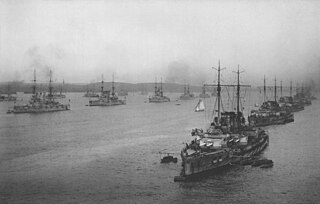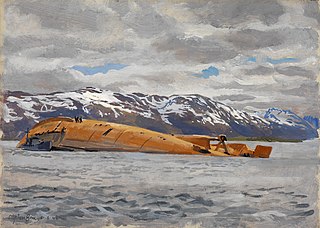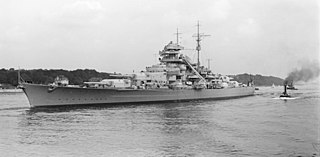
The Imperial German Navy or the Imperial Navy was the navy of the German Empire, which existed between 1871 and 1919. It grew out of the small Prussian Navy, which was mainly for coast defence. Kaiser Wilhelm II greatly expanded the navy. The key leader was Admiral Alfred von Tirpitz, who greatly expanded the size and quality of the navy, while adopting the sea power theories of American strategist Alfred Thayer Mahan. The result was a naval arms race with Britain, as the German navy grew to become one of the greatest maritime forces in the world, second only to the Royal Navy.

The Kriegsmarine was the navy of Germany from 1935 to 1945. It superseded the Imperial German Navy of the German Empire (1871–1918) and the inter-war Reichsmarine (1919–1935) of the Weimar Republic. The Kriegsmarine was one of three official branches, along with the Heer and the Luftwaffe, of the Wehrmacht, the German armed forces from 1935 to 1945.

Erich Johann Albert Raeder was a German admiral who played a major role in the naval history of World War II, and was convicted of war crimes after the war. Raeder attained the highest possible naval rank, that of grand admiral, in 1939, becoming the first person to hold that rank since Henning von Holtzendorff in 1918. Raeder led the Kriegsmarine for the first half of the war; he resigned in January 1943 and was replaced by Karl Dönitz. At the Nuremberg trials he was sentenced to life imprisonment but was released early owing to failing health.

Alfred Peter Friedrich von Tirpitz was a German grand admiral, Secretary of State of the German Imperial Naval Office, the powerful administrative branch of the German Imperial Navy from 1897 until 1916.
Plan Z was the name given to the planned re-equipment and expansion of the Kriegsmarine ordered by Adolf Hitler in early 1939. The fleet was meant to challenge the naval power of the United Kingdom, and was to be completed by 1948. Development of the plan began in 1938, but it reflected the evolution of the strategic thinking of the Oberkommando der Marine over the two decades following World War I. The plan called for a fleet centered on ten battleships and four aircraft carriers which were intended to battle the Royal Navy. This force would be supplemented with numerous long-range cruisers that would attack British shipping. A relatively small force of U-boats was also stipulated.

Operation Sportpalast, also known as Operation Nordmeer, was a German naval raid between 6 and 13 March 1942 against two of the Allied Arctic convoys of World War II as they passed through the Norwegian Sea. It was conducted by the battleship Tirpitz, three destroyers and eight submarines. The German ships were unable to locate either of the convoys but sank a merchant vessel that was sailing independently. The Allies attempted to intercept the German force, also without success.
The Naval Laws were five separate laws passed by the German Empire, in 1898, 1900, 1906, 1908, and 1912. These acts, championed by Kaiser Wilhelm II and his Secretary of State for the Navy, Grand Admiral Alfred von Tirpitz, committed Germany to building up a navy capable of competing with the Royal Navy of the United Kingdom.

Operation Tungsten was a Second World War Royal Navy air raid that targeted the German battleship Tirpitz. The operation sought to damage or destroy Tirpitz at her base in Kaafjord in the far north of Norway before she could become fully operational again following a period of repairs.

The Helgoland class was the second class of dreadnought battleships to be built for the German Kaiserliche Marine. Constructed from 1908 to 1912, the class comprised four ships: Helgoland, the lead ship; Oldenburg; Ostfriesland; and Thüringen. The design was a significant improvement over the previous Nassau-class ships; they had a larger main battery—30.5 cm (12 in) main guns instead of the 28 cm (11 in) weapons mounted on the earlier vessels—and an improved propulsion system. The Helgolands were easily distinguished from the preceding Nassaus by the three funnels that were closely arranged, compared to the two larger funnels of the previous class. The ships retained the hexagonal main battery layout of the Nassau class.

Operation Catechism was a British air raid of World War II that destroyed the German battleship Tirpitz. It was conducted on 12 November 1944 by 29 Royal Air Force heavy bombers that attacked the battleship at its anchorage near the Norwegian city of Tromsø. The ship capsized after being hit by at least two bombs and damaged by the explosions of others, killing between 940 and 1,204 members of the crew; the British suffered no casualties.
Imperial German plans for the invasion of the United States were ordered by staff officers from 1897 to 1903 as training exercises in planning for war. The hypothetical operation was supposed to force the US to bargain from a weak position and to sever its growing economic and political connections in the Pacific Ocean, the Caribbean, and South America so that German influence could increase there. Junior officers made various plans, but none were seriously considered and the project was dropped in 1906.

World War II saw the end of the battleship as the dominant force in the world's navies. At the outbreak of the war, large fleets of battleships—many inherited from the dreadnought era decades before—were one of the decisive forces in naval thinking. By the end of the war, battleship construction was all but halted, and almost every remaining battleship was retired or scrapped within a few years of its end.
The arms race between Great Britain and Germany that occurred from the last decade of the nineteenth century until the advent of World War I in 1914 was one of the intertwined causes of that conflict. While based in a bilateral relationship that had worsened over many decades, the arms race began with a plan by German Admiral Alfred von Tirpitz in 1897 to create a fleet in being to force Britain to make diplomatic concessions; Tirpitz did not expect the Imperial German Navy to defeat the Royal Navy.

The Bismarck class was a pair of fast battleships built for Nazi Germany's Kriegsmarine shortly before the outbreak of World War II. The ships were the largest and most powerful warships built for the Kriegsmarine; displacing more than 41,000 metric tons normally, they were armed with a battery of eight 38 cm (15 in) guns and were capable of a top speed of 30 knots. Bismarck was laid down in July 1936 and completed in September 1940, while her sister Tirpitz's keel was laid in October 1936 and work finished in February 1941. The ships were ordered in response to the French Richelieu-class battleships. They were designed with the traditional role of engaging enemy battleships in home waters in mind, though the German naval command envisioned employing the ships as long-range commerce raiders against British shipping in the Atlantic Ocean. As such, their design represented strategic confusion that dominated German naval construction in the 1930s.

Tirpitz was the second of two Bismarck-class battleships built for Nazi Germany's Kriegsmarine (navy) prior to and during the Second World War. Named after Grand Admiral Alfred von Tirpitz, the architect of the Kaiserliche Marine, the ship was laid down at the Kriegsmarinewerft in Wilhelmshaven in November 1936 and her hull was launched two and a half years later. Work was completed in February 1941, when she was commissioned into the German fleet. Like her sister ship, Bismarck, Tirpitz was armed with a main battery of eight 38-centimetre (15 in) guns in four twin turrets. After a series of wartime modifications she was 2000 tonnes heavier than Bismarck, making her the heaviest battleship ever built by a European navy.

The High Seas Fleet (Hochseeflotte) was the battle fleet of the German Imperial Navy and saw action during the First World War. The formation was created in February 1907, when the Home Fleet (Heimatflotte) was renamed as the High Seas Fleet. Admiral Alfred von Tirpitz was the architect of the fleet; he envisioned a force powerful enough to challenge the Royal Navy's predominance. Kaiser Wilhelm II, the German Emperor, championed the fleet as the instrument by which he would seize overseas possessions and make Germany a global power. By concentrating a powerful battle fleet in the North Sea while the Royal Navy was required to disperse its forces around the British Empire, Tirpitz believed Germany could achieve a balance of force that could seriously damage British naval hegemony. This was the heart of Tirpitz's "Risk Theory", which held that Britain would not challenge Germany if the latter's fleet posed such a significant threat to its own.

Z29 was one of fifteen Type 1936A destroyers built for the Kriegsmarine during World War II. Completed in 1941, she took part in the Channel Dash in early 1942 as flagship of the escort force. Despite this venture to France, the ship spent most of the war in Norwegian waters, escorting German ships and laying minefields. Z29 participated in the indecisive Battle of the Barents Sea at the end of the year, during which she helped to sink a British minesweeper. The ship was damaged during the raid on the island of Spitsbergen in September 1943. Z29 was damaged by British aircraft attacking the battleship Tirpitz in July 1944. The ship escorted troop convoys from northern Norway when the Germans began evacuating the area beginning in October until she began an extensive refit in December.

Operation Mascot was an unsuccessful British carrier air raid conducted against the German battleship Tirpitz at her anchorage in Kaafjord, Norway, on 17 July 1944. The attack was one of a series of strikes against the battleship launched from aircraft carriers between April and August 1944, and was initiated after Allied intelligence determined that the damage inflicted during the Operation Tungsten raid on 3 April had been repaired.













